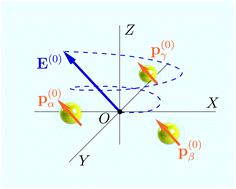当前位置:
X-MOL 学术
›
Soft Matter
›
论文详情
Our official English website, www.x-mol.net, welcomes your
feedback! (Note: you will need to create a separate account there.)
Colloids in rotating electric and magnetic fields: designing tunable interactions with spatial field hodographs.
Soft Matter ( IF 2.9 ) Pub Date : 2020-07-23 , DOI: 10.1039/d0sm01046d Kirill A Komarov 1 , Stanislav O Yurchenko 2
Soft Matter ( IF 2.9 ) Pub Date : 2020-07-23 , DOI: 10.1039/d0sm01046d Kirill A Komarov 1 , Stanislav O Yurchenko 2
Affiliation

|
Opening a way to designing tunable interactions between colloidal particles in rotating electric and magnetic fields provides rich opportunities both for fundamental studies of phase transitions and engineering of soft materials. Spatial hodographs, showing the distribution of the field magnitude and orientation, allow the adjustment of interactions and can be an extremely potent tool for prospective experiments, but remain unstudied systematically. Here, we calculate the tunable interactions between spherical particles in rhodonea, conical, cylindrical, and ellipsoidal field hodographs, as the most experimentally important cases. We discovered that spatial hodographs are reduced to each other, providing a plethora of interactions, e.g., repulsive, attractive, barrier-like, and double-scale repulsive ones. Complementing the “magic” conical angle, the “magic” compression and ellipticity of cylindrical and ellipsoidal hodographs are introduced. In the “magic” hodographs, the interactions become spatially isotropic and attain dispersion-force-like asymptotic (the same for pairwise and many-body energies), being attractive or repulsive, if the particle permittivity is larger or smaller than that of the solvent. With the diagrammatic method and numerical calculations, we obtained physically meaningful fits to the many-body tunable potentials for silica (iron oxide) particles in deionised water in the rotating electric (magnetic) fields. Our results provide essential guidance for future experiments and simulations of colloidal liquids, crystals, gels, and glasses, important for a broad range of problems in condensed matter, chemical physics, physical chemistry, materials science, and soft matter.
中文翻译:

旋转电场和磁场中的胶体:设计与空间场全息图的可调相互作用。
为在旋转电场和磁场中设计胶体粒子之间的可调相互作用开辟了道路,这为相变的基础研究和软材料工程提供了丰富的机会。空间全息图显示了场大小和方向的分布,可以调整相互作用,并且可以用作前瞻性实验的强大工具,但仍需系统地研究。在这里,我们计算球形的粒子在红景天,圆锥形,圆柱形和椭圆形场全息图中的可调相互作用,这是实验上最重要的情况。我们发现空间全息图相互简化,从而提供了大量的交互作用,例如,排斥,诱人,类似障碍物和双比例排斥。作为“魔术”圆锥角的补充,圆柱和椭圆形全息图的“魔术”压缩和椭圆率被引入。在“魔术”全息图中,如果粒子介电常数大于或小于溶剂的介电常数,则相互作用变为空间各向同性,并达到分散力状的渐近性(成对和多体能量相同),具有吸引力或排斥性。通过图解方法和数值计算,我们获得了在旋转电场(磁场)中去离子水中二氧化硅(氧化铁)颗粒的多体可调电位的物理意义的拟合。我们的结果为胶体液体,晶体,凝胶和玻璃的未来实验和模拟提供了重要的指导,
更新日期:2020-09-16
中文翻译:

旋转电场和磁场中的胶体:设计与空间场全息图的可调相互作用。
为在旋转电场和磁场中设计胶体粒子之间的可调相互作用开辟了道路,这为相变的基础研究和软材料工程提供了丰富的机会。空间全息图显示了场大小和方向的分布,可以调整相互作用,并且可以用作前瞻性实验的强大工具,但仍需系统地研究。在这里,我们计算球形的粒子在红景天,圆锥形,圆柱形和椭圆形场全息图中的可调相互作用,这是实验上最重要的情况。我们发现空间全息图相互简化,从而提供了大量的交互作用,例如,排斥,诱人,类似障碍物和双比例排斥。作为“魔术”圆锥角的补充,圆柱和椭圆形全息图的“魔术”压缩和椭圆率被引入。在“魔术”全息图中,如果粒子介电常数大于或小于溶剂的介电常数,则相互作用变为空间各向同性,并达到分散力状的渐近性(成对和多体能量相同),具有吸引力或排斥性。通过图解方法和数值计算,我们获得了在旋转电场(磁场)中去离子水中二氧化硅(氧化铁)颗粒的多体可调电位的物理意义的拟合。我们的结果为胶体液体,晶体,凝胶和玻璃的未来实验和模拟提供了重要的指导,











































 京公网安备 11010802027423号
京公网安备 11010802027423号